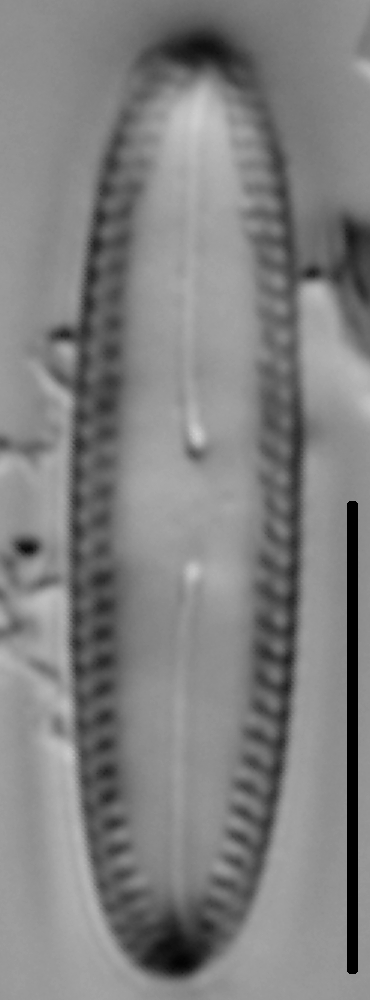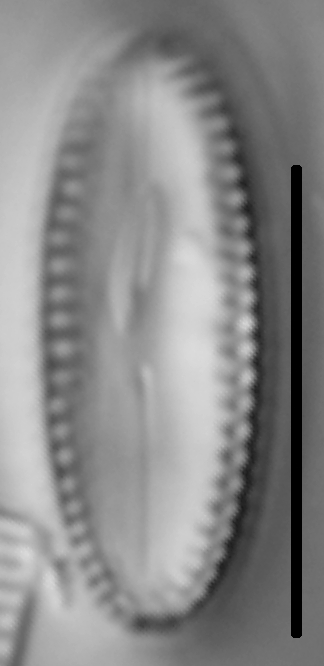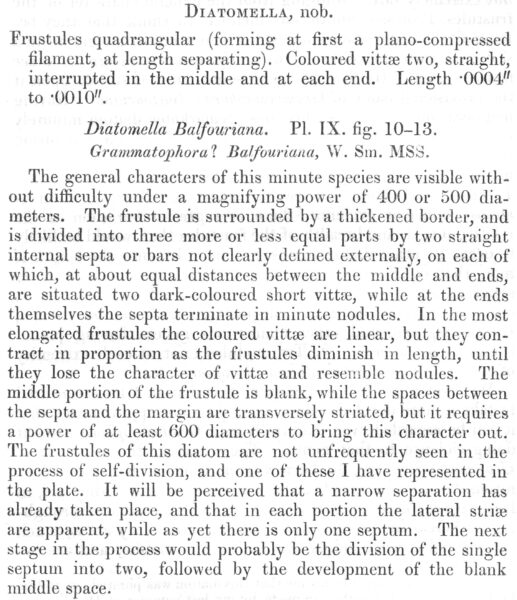Diatomella balfouriana
-
Category
-
Length Range12-40 µm
-
Width Range3.5-6.0 µm
-
Striae in 10 µm18-22
-
ContributorPat Kociolek - Mar 2011
-
ReviewerMark Edlund - Aug 2011
Identification
Description
Valves are linear with rounded apices. The axial area is wide. The raphe is filiform, arcuate, with dilated external proximal raphe ends that terminate relatively distant from one another. The striae are short and parallel to radiate, not distinctly punctate. A septum is present on each valvocopula. The septum extends the entire length of the valve and has three large openings, the largest in the center and two smaller at the ends.
This species is found in mountain streams and aerophilous habitats, particularly in the western US.
Autecology
-
Size Range, µm3
-
Motility
-
Attachment
-
Habitat
-
Colony
-
BCG
-
Waterbody
-
Distribution
- Learn more about this
Original Description
DIATOMELLA, nob. Frustules quadrangular (forming at first a plano-compressed filament, at length separating) . Coloured vittæ two, straight, interrupted in the middle and at each end. Length •0004'' to •0010". Diatomella Balfouriana. Pl. IX. fig. 10-13. Grannmatophora ? Βalfouriana, W. Sm. MSS. The general characters of this minute species are visible with¬out difficulty under a magnifying power of 400 or 500 diameters. The frustule is surrounded by a thickened border, and is divided into three more or less equal parts by two straight internal septa or bars not clearly defined externally, on each of which, at about equal distances between the middle and ends, are situated two dark-coloured short vittæ, while at the ends themselves the septa terminate in minute nodules. In the most elongated frustules the coloured vittæ are linear, but they contract in proportion as the frustules diminish in length, until they lose the character of vittæ and resemble nodules. The middle portion of the frustule is blank, while the spaces between the septa and the margin are transversely striated, but it requires a power of at least 600 diameters to bring this character out. The frustules of this diatom are not unfrequently seen in the process of self-division, and one of these I have represented in the plate. It will be perceived that a narrow separation has already taken place, and that in each portion the lateral striae are apparent, while as yet there is only one septum. The next stage in the process would probably be the division of the single septum into two, followed by the development of the blank middle space.
-
AuthorGrev. 1855
Citations & Links
Citations
-
Publication Link: 10.1080/0269249X.2012.720612
Links
-
Index Nominum Algarum
-
North American Diatom Ecological DatabaseNADED ID: 28001
Cite This Page
Kociolek, P. (2011). Diatomella balfouriana. In Diatoms of North America. Retrieved April 23, 2024, from https://diatoms.org/species/diatomella_balfouriana
Responses
The 15 response plots show an environmental variable (x axis) against the relative abundance (y axis) of Diatomella balfouriana from all the stream reaches where it was present. Note that the relative abundance scale is the same on each plot. Explanation of each environmental variable and units are as follows:
ELEVATION = stream reach elevation (meters)
STRAHLER = distribution plot of the Strahler Stream Order
SLOPE = stream reach gradient (degrees)
W1_HALL = an index that is a measure of streamside (riparian) human activity that ranges from 0 - 10, with a value of 0 indicating of minimal disturbance to a value of 10 indicating severe disturbance.
PHSTVL = pH measured in a sealed syringe sample (pH units)
log_COND = log concentration of specific conductivity (µS/cm)
log_PTL = log concentration of total phosphorus (µg/L)
log_NO3 = log concentration of nitrate (µeq/L)
log_DOC = log concentration of dissolved organic carbon (mg/L)
log_SIO2 = log concentration of silicon (mg/L)
log_NA = log concentration of sodium (µeq/L)
log_HCO3 = log concentration of the bicarbonate ion (µeq/L)
EMBED = percent of the stream substrate that is embedded by sand and fine sediment
log_TURBIDITY = log of turbidity, a measure of cloudiness of water, in nephelometric turbidity units (NTU).
DISTOT = an index of total human disturbance in the watershed that ranges from 1 - 100, with a value of 0 indicating of minimal disturbance to a value of 100 indicating severe disturbance.

Diatomella balfouriana
- Valves linear with rounded apices
- Septum present
- Axial area wide
- Proximal raphe ends distant
Valves linear, with rounded apices. The axial area is wide. A septum is present extending the entire length of the valve, and has three large openings, the largest in the center, smaller two at the ends. The proximal raphe ends are relatively distant from one another; they are widely spaced.
 Diatoms of North America
Diatoms of North America







